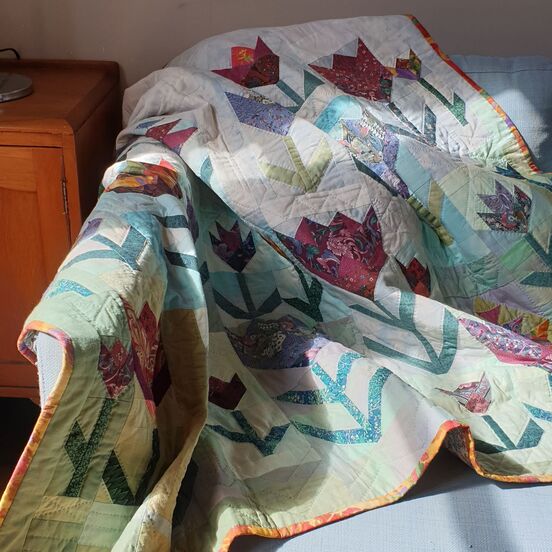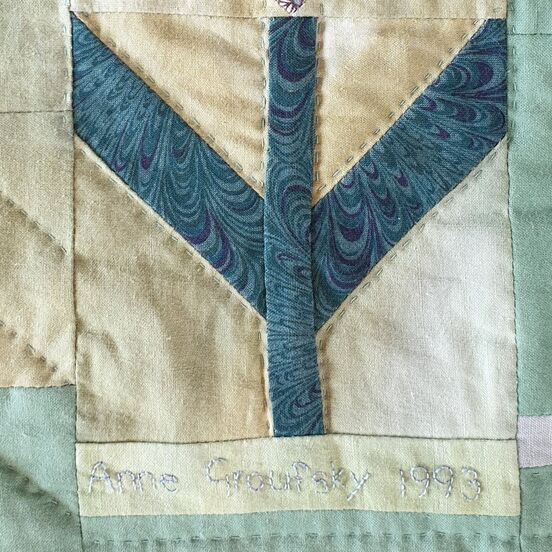-
Author
Jane Groufsky -
Date
9 Apr 2020
Essay
The Single Object At Home Edition: Indian Summer
My mum Anne gave me this quilt, Indian Summer, about 10 days before the lockdown, but it’s almost as old as I am. It came to me as part of a clear-out of her considerable quilt stash from a lifetime of developing her craft. Initially made for display rather than use, Indian Summer spent many years on my aunt’s living room wall and is now faded enough to be relegated to the couch, and not too precious to worry about my new kittens chewing on the odd corner.
If the date 1993 wasn’t embroidered on the front I’d probably still guess it from the fabrics. As a textile historian, I’ve built up a feeling for knowing what era a fabric comes from even when the actual print is unfamiliar, the same way you can see a photo of a street you’ve never visited but still instinctively know that it’s in a town you’ve lived in. There’s something about washy hand-dyed fabrics and the colour mauve which scream “early nineties”. Even quilts go through fashions, although they might seem unchanging and traditional.
Recently I finished my third quilt, made from a piece of fabric I had block-printed. I called Mum to talk through the process and mentioned that I planned to machine-quilt1 circles. She drew on her decades of experience to explain to me in great detail why that would be a nightmare, and recommended that I do straight lines instead. Naturally I tried to machine-sew circles and they were a horrible twisted mess. Reasoning that this was due to the many layers of the quilt bunching under the arm of the sewing machine, I then attempted to hand-quilt circles with just a needle and thread. I gave that up after about ten minutes and five stitches, and went back to the machine to sew straight lines which intersected to form hexagons. It worked perfectly.
When I look at Indian Summer now, I see the hand-quilting which must have taken many evenings, and the patchwork triangles which had to be measured and cut and sewn so precisely to line up perfectly. I understand why my circles didn’t work, just as burgeoning bakers in lockdown across the country are learning why you can’t really make a delicious loaf out of an “easy three ingredient bread” recipe where one of the ingredients is mayonnaise. With so many people picking up new hobbies in this time of isolation, I hope they’re experiencing this form of learning for themselves and pushing through the setbacks. I hope that when we come out the other side of this, it will encourage a new value of and appreciation for the handmade. Maybe I won’t let my kittens chew on Indian Summer after all.
1 Quilting is the process in which the layers of the quilt top, batting, and backing fabric are all sewn together to create one layer.
--
Jane Groufsky is project curator history at Auckland Museum Tamaki Paenga Hira and a committee member of the Costume and Textile Association of New Zealand. Her research focusses on the history of printed and patterned textiles in New Zealand, and she is a dilettante textile designer on the side.

Anne Groufsky, Indian summer. Image: Jane Groufsky

Anne Groufsky, Indian Summer. Detail shot